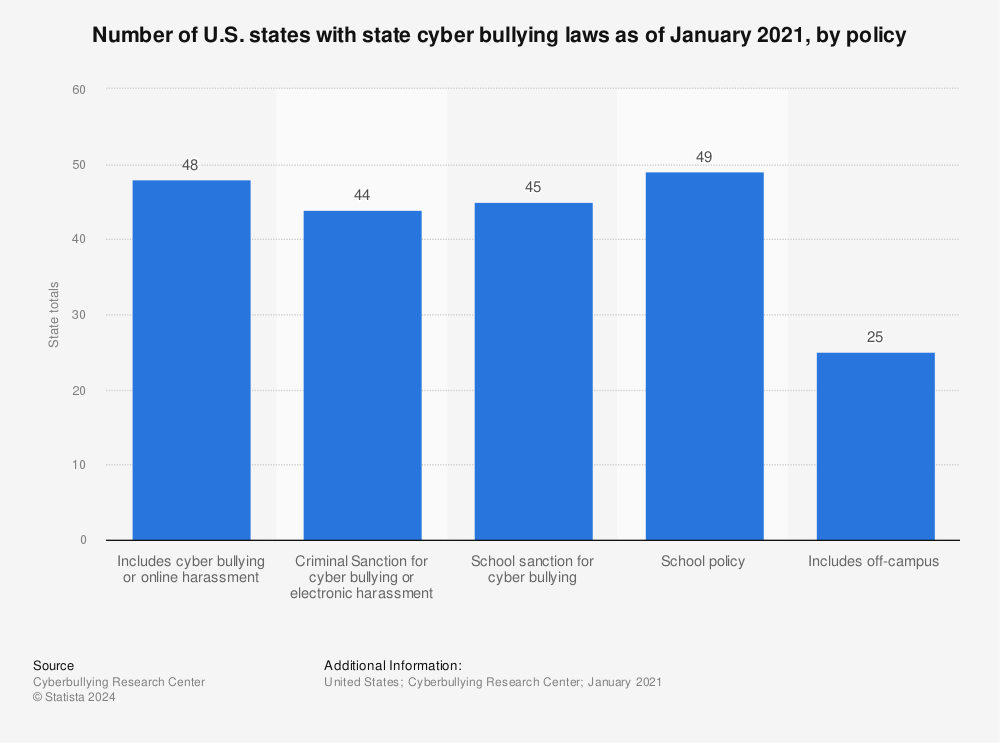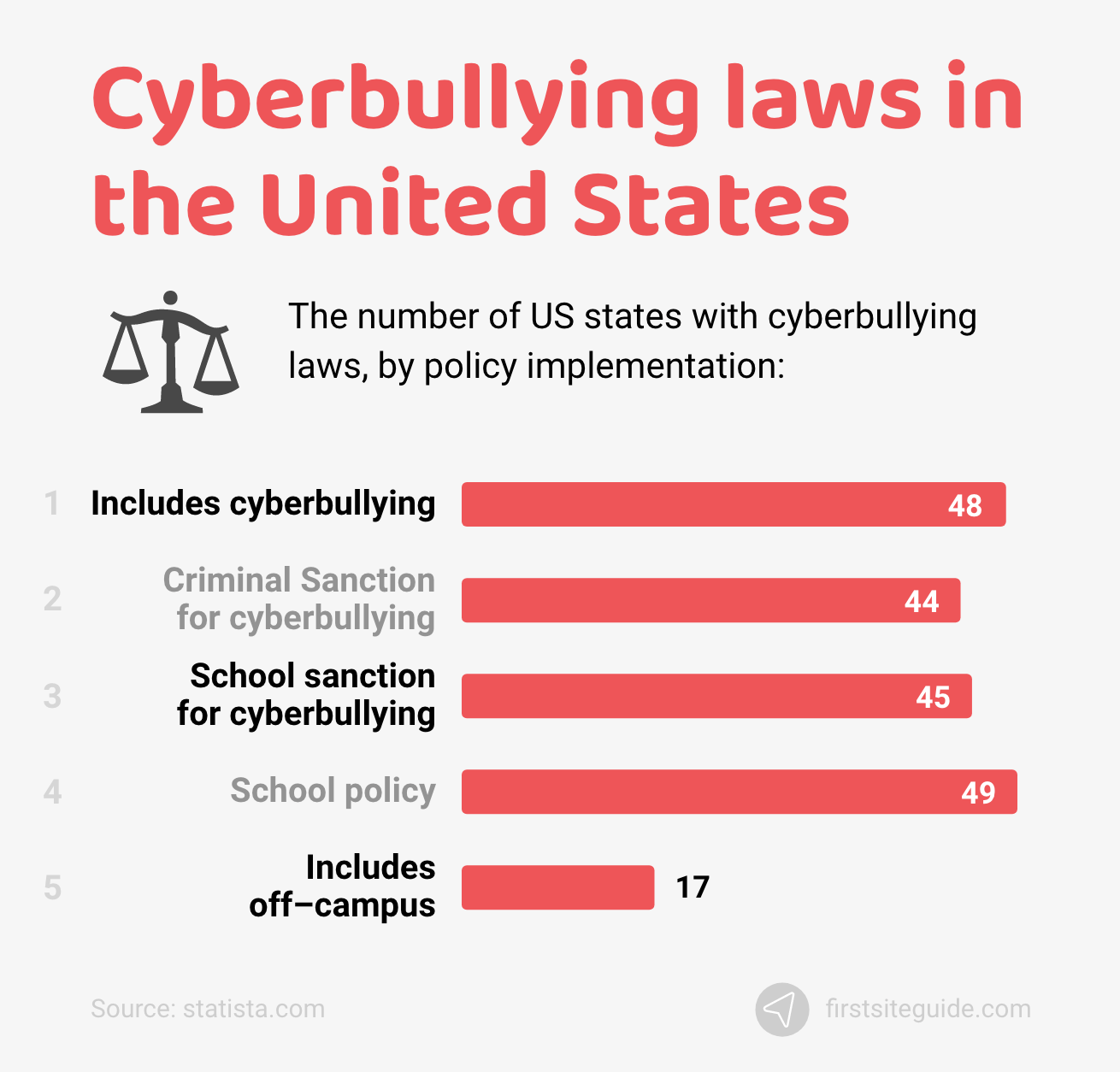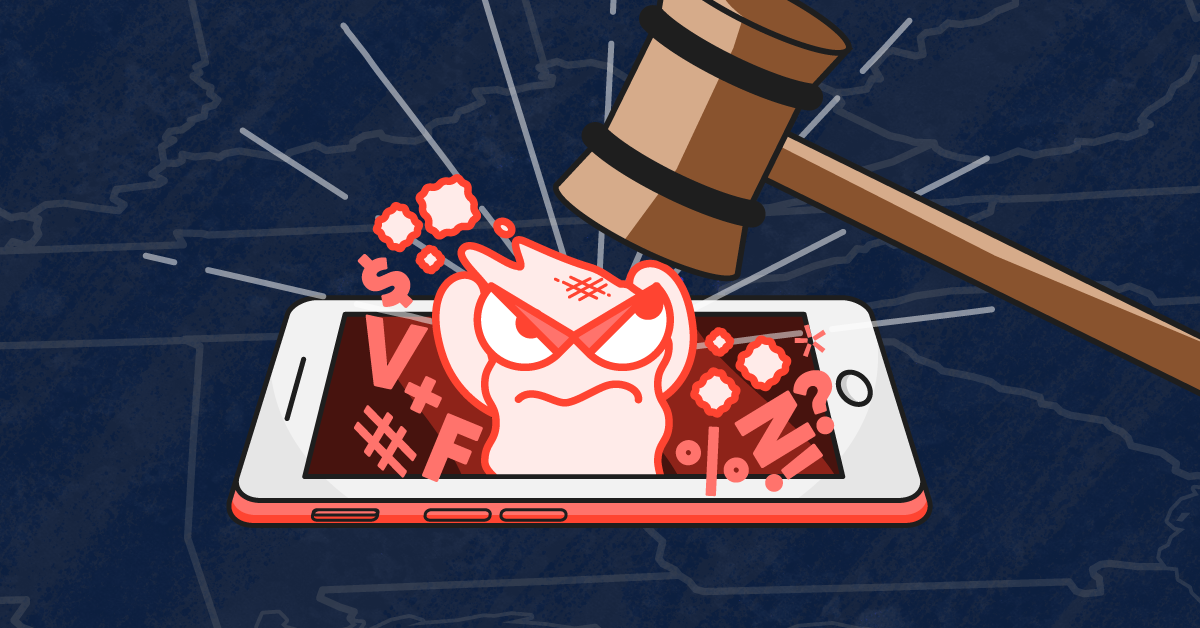Cyberbullying is a serious issue affecting many in the USA. Laws have been created to address this growing problem.
So, what are cyberbullying laws in the USA? Cyberbullying involves using technology to harass, threaten, or embarrass someone. It can happen through texts, social media, or emails. The rise of cyberbullying has led to the creation of specific laws. Each state has its own set of rules and penalties.
These laws aim to protect victims and hold bullies accountable. Understanding these laws can help prevent cyberbullying. It also empowers victims to seek justice. In this blog, we will explore these laws in detail. We will also look at how they are enforced and what steps you can take if you or someone you know is a victim.
Introduction To Cyberbullying Laws
The rise of digital communication has brought new challenges, including cyberbullying. As more people connect online, the need for laws to protect individuals from online harassment has grown. This section covers the basics of cyberbullying laws in the USA.
Definition Of Cyberbullying
Cyberbullying involves using digital devices to harass or threaten someone. It can happen through texts, social media, and other online platforms. Common forms include:
- Sending threatening messages
- Posting harmful rumors
- Sharing private information without consent
These actions can cause emotional distress and impact mental health. Recognizing these behaviors helps in understanding the need for legal protection.
Importance Of Cyberbullying Laws
Cyberbullying laws are crucial for several reasons. First, they provide a legal framework to address online harassment. This helps victims seek justice and hold bullies accountable. Second, these laws promote a safer online environment. They deter potential bullies by outlining clear consequences.
Here are some benefits of cyberbullying laws:
- Protection for Victims: Laws ensure victims have a way to report and stop abuse.
- Accountability: Bullies face legal consequences, discouraging further harassment.
- Awareness: Legal measures raise public awareness about the seriousness of cyberbullying.
Each state in the USA has its own set of cyberbullying laws. While they differ, the goal remains the same: to protect individuals from online harm.
| State | Cyberbullying Law |
|---|---|
| California | Includes online threats and harassment in its bullying laws. |
| New York | Has specific laws addressing electronic harassment. |
| Texas | Cyberbullying included in school district policies. |
Understanding these laws helps individuals protect themselves and others from cyberbullying.

Credit: www.statista.com
Federal Laws On Cyberbullying
Cyberbullying is a growing concern in the digital age. While many states have their own laws, federal legislation plays a crucial role. This section will explore existing and proposed federal laws on cyberbullying in the USA.
Existing Federal Legislation
Currently, no specific federal law targets cyberbullying. However, several federal statutes address related issues:
- Children’s Online Privacy Protection Act (COPPA): Protects the privacy of children under 13 online.
- Computer Fraud and Abuse Act (CFAA): Addresses hacking and unauthorized access to computers.
- Interstate Communications Act: Criminalizes threatening communications sent across state lines.
These laws help to tackle certain aspects of cyberbullying. Yet, they do not offer comprehensive protection.
Proposed Federal Laws
Several proposed laws aim to address cyberbullying more directly:
- Megan Meier Cyberbullying Prevention Act: Seeks to criminalize cyberbullying that leads to severe emotional distress.
- Safe Schools Improvement Act: Aims to mandate schools to adopt anti-bullying policies.
- Tyler Clementi Higher Education Anti-Harassment Act: Focuses on preventing harassment in colleges and universities.
These proposals reflect the growing recognition of cyberbullying’s impact. Lawmakers continue to work on passing these laws.
Understanding federal laws is essential for combating cyberbullying. Stay informed and support these efforts to create safer online spaces.
State-specific Cyberbullying Laws
Cyberbullying laws in the USA vary by state. Each state has its own rules and regulations to address cyberbullying. Understanding these differences is crucial for parents, educators, and students.
Variations By State
Each state defines cyberbullying differently. Some states include cyberbullying in their general bullying laws. Others have specific laws targeting online harassment.
For example, some states focus on the intent of the bully. They look at whether the bully aimed to cause fear or harm. Other states consider the impact on the victim. They look at how the victim feels and reacts.
In some states, cyberbullying laws apply to all online activities. This includes social media, emails, and text messages. In other states, laws only apply to school-related activities. These can include school devices and networks.
Examples Of State Laws
Let’s look at a few examples to understand the differences:
- California: California’s law includes any electronic act. It covers messages, texts, and images. The law applies if the act causes fear or harm.
- New York: New York’s law focuses on school settings. It includes any act that disrupts the education process. The law requires schools to have policies against cyberbullying.
- Texas: Texas has a separate cyberbullying law. It targets severe cases. The law allows schools to expel students for extreme cyberbullying.
These examples show how state laws can differ. Some states focus on prevention. Others focus on punishment. Knowing your state’s laws can help you understand your rights and responsibilities.

Credit: firstsiteguide.com
Impact Of Cyberbullying Laws
Cyberbullying laws in the USA play a crucial role in addressing online harassment. These laws aim to protect victims and hold perpetrators accountable. Understanding the impact of these laws helps us see their importance in our digital age.
Legal Consequences
Cyberbullying can lead to serious legal consequences. Offenders may face fines, community service, or jail time. Schools can also take disciplinary actions like suspension or expulsion. These measures aim to deter individuals from engaging in harmful online behavior.
Effectiveness Of Current Laws
The effectiveness of current cyberbullying laws varies. Some states have stronger laws, while others are still developing them. These laws help raise awareness and provide a framework for addressing online harassment. However, enforcement can be challenging due to the anonymous nature of the internet.
Despite these challenges, these laws are vital. They provide victims with legal recourse and help create a safer online environment. Continuous evaluation and updates are necessary to keep pace with evolving digital trends.
Role Of Schools In Cyberbullying Prevention
The role of schools in cyberbullying prevention is crucial. Schools can create safe environments for students. They can enforce policies and offer support. Let’s explore how schools can help prevent cyberbullying.
School Policies
Schools can set clear policies against cyberbullying. These policies should define what counts as cyberbullying. They should also outline the consequences for such behavior. Clear policies help students understand the seriousness of the issue.
Schools should communicate these policies to students, parents, and staff. This ensures everyone knows the rules. Regular updates to the policies can keep them effective. Schools can also create reporting systems. These systems allow students to report cyberbullying safely.
Educational Programs
Educational programs can teach students about the effects of cyberbullying. These programs can show how hurtful online behavior can be. They can also provide strategies for dealing with cyberbullying. Teaching empathy and respect is important. Schools can hold workshops and seminars.
Schools can also involve parents. Parent-teacher meetings can include discussions on cyberbullying. Providing resources and support for parents can help them guide their children. Education is key to preventing cyberbullying. With the right programs, schools can make a difference.
Legal Rights Of Victims
Victims of cyberbullying in the USA have specific legal rights. Understanding these rights can help victims take action and seek justice. This section covers what victims can do legally to protect themselves and hold perpetrators accountable.
Filing A Complaint
The first step for victims is to file a complaint. They can report the cyberbullying to local law enforcement. Keeping evidence like screenshots and messages is crucial. This documentation helps in proving the case. Schools also have policies to handle cyberbullying. Reporting to school authorities can bring immediate relief.
Seeking Legal Action
Victims can seek legal action against the bully. Many states have laws against cyberbullying. These laws can lead to fines or jail time for the perpetrator. Victims may also file civil lawsuits. They can seek damages for emotional distress. Consulting with a lawyer helps in understanding the best legal options.
Challenges In Enforcing Cyberbullying Laws
Enforcing cyberbullying laws in the USA is complex. The digital world presents unique challenges. Authorities face multiple obstacles in ensuring justice for victims. Below, we discuss two major hurdles: jurisdictional issues and proving cyberbullying.
Jurisdictional Issues
One key challenge is jurisdictional issues. Cyberbullying often crosses state lines. This makes it hard for law enforcement to determine who has authority. Different states have different laws. This can lead to confusion and inconsistent enforcement.
For example, if a bully is in one state and the victim in another, both states’ laws may apply. Coordination between state agencies becomes necessary. This can slow down investigations and legal proceedings.
Proving Cyberbullying
Another significant challenge is proving cyberbullying. Evidence collection in the digital world is tricky. Cyberbullies use various platforms like social media, messaging apps, and forums. Tracking and gathering this evidence is difficult.
Victims may delete messages or posts. This can erase crucial evidence. Additionally, bullies often use fake profiles or anonymous accounts. This makes it hard to identify them. Law enforcement must work with tech companies to retrieve data. This process can be lengthy and complex.
In summary, enforcing cyberbullying laws is not straightforward. Jurisdictional issues and proving cyberbullying are two major hurdles. Authorities need better tools and coordination to tackle these challenges effectively.

Credit: www.bark.us
Future Of Cyberbullying Legislation
The landscape of cyberbullying laws in the USA is evolving. As technology advances, so do the methods of online harassment. Legislators are working to address these changes and protect victims.
Potential Law Reforms
There are several areas where law reforms may occur. These changes can help make cyberbullying laws more effective.
- Stricter Penalties: Increasing penalties for cyberbullying could deter potential offenders.
- Broader Definitions: Expanding the definition of cyberbullying to cover more behaviors.
- Enhanced Reporting Systems: Making it easier for victims to report incidents.
- Support Services: Providing better support for victims of cyberbullying.
Advocacy And Awareness
Advocacy groups play a crucial role in shaping cyberbullying legislation. They raise awareness and push for stronger laws.
These groups often work with schools, parents, and lawmakers to highlight the importance of addressing cyberbullying.
- Hosting educational programs
- Creating awareness campaigns
- Providing resources to victims
By increasing awareness, advocacy groups help ensure that cyberbullying is taken seriously. This can lead to more effective laws and better protection for victims.
Frequently Asked Questions
What Is Cyberbullying In The Usa?
Cyberbullying in the USA involves using digital platforms to harass, threaten, or humiliate others. It includes sending harmful messages, spreading rumors, or posting embarrassing content online.
Are There Federal Laws Against Cyberbullying?
There are no specific federal laws against cyberbullying. However, certain actions may be covered under federal laws related to harassment or stalking.
How Do States Address Cyberbullying?
Many states have specific laws addressing cyberbullying. These laws vary, but they generally include penalties for online harassment and bullying.
Can Schools Take Action Against Cyberbullying?
Yes, schools can take action against cyberbullying. Many states require schools to implement policies to prevent and address cyberbullying incidents.
Conclusion
Cyberbullying laws in the USA aim to protect individuals from online harm. Understanding these laws helps in knowing your rights and responsibilities. Each state has different rules, but all focus on reducing online harassment. Reporting cyberbullying can make a big difference.
Stay informed and safe. Knowledge of these laws empowers you. Taking action can help stop cyberbullying. Stay vigilant and support those affected. Let’s work together to create a safer online environment for everyone.
Disclaimer: The content on this page is for general information only and should not be considered legal advice. We work hard to provide accurate and up-to-date details, but we can't guarantee the completeness or accuracy of the information. Laws and rules change often, and interpretations may vary. For specific advice, always consult a qualified legal expert. We are not liable for any actions you take based on this information. If you spot any errors or outdated content, please contact us, and we’ll update it as soon as possible.


